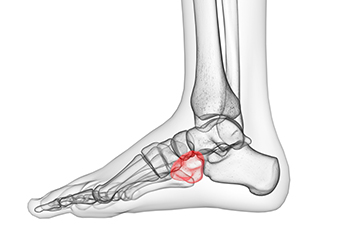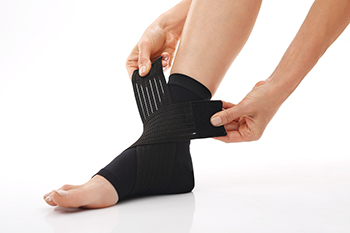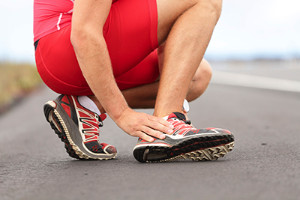

In cuboid syndrome, the small, square-shaped cuboid bone on the outside of the midfoot becomes partially dislocated. Cuboid syndrome can cause foot pain in this area, along with weakness in the foot. This condition may occur when the ankle has been sprained or twisted, through overuse/repetitive strain, or by having flat feet. Along with pain and/or foot weakness, there may be redness, swelling, or bruising on the outside of the midfoot. If you suspect that you have cuboid syndrome, contact a podiatrist. They will examine to see exactly where the pain is emanating from. If they determine that you have cuboid syndrome, they may try to treat it with rest, ice therapy, orthotics, and taping. They may even determine that manipulating the bone back into alignment is possible with procedures known as the cuboid whip or the cuboid squeeze. Manipulation is more successful if it is performed shortly after the injury has occurred, so it is important to seek treatment from a podiatrist as soon as possible.
Cuboid syndrome, also known as cuboid subluxation, occurs when the joints and ligaments near the cuboid bone in the foot become torn. If you have cuboid syndrome, consult with Dr. Thomas Tran from Southwestern Foot & Ankle Associates, P.C.. Our doctor will assess your condition and provide you with quality foot and ankle treatment.
Cuboid syndrome is a common cause of lateral foot pain, which is pain on the outside of the foot. The condition may happen suddenly due to an ankle sprain, or it may develop slowly overtime from repetitive tension through the bone and surrounding structures.
Causes
The most common causes of cuboid syndrome include:
Symptoms
A common symptom of cuboid syndrome is pain along the outside of the foot which can be felt in the ankle and toes. This pain may create walking difficulties and may cause those with the condition to walk with a limp.
Diagnosis
Diagnosis of cuboid syndrome is often difficult, and it is often misdiagnosed. X-rays, MRIs and CT scans often fail to properly show the cuboid subluxation. Although there isn’t a specific test used to diagnose cuboid syndrome, your podiatrist will usually check if pain is felt while pressing firmly on the cuboid bone of your foot.
Treatment
Just as the range of causes varies widely, so do treatments. Some more common treatments are ice therapy, rest, exercise, taping, and orthotics.
If you have any questions, please feel free to contact our office located in Frisco, TX . We offer the newest diagnostic and treatment technologies for all your foot care needs.

Ankle braces can help to support a weak ankle joint, as well as increase your mobility and protect the ankle from further injury. Anyone who has problems with plantar fasciitis, tendonitis, or previous ankle joint injuries may find it helpful to wear a brace. Experts believe it is best to wear an ankle brace after an injury, rather than beforehand, as a preventive measure. Constant use of an ankle brace can actually cause more harm than good, as it may prevent the surrounding muscles from gaining strength. Using a brace on occasion, say for a hike on uneven terrain or when playing a sport with a lot of lateral movement, is recommended. After an injury, a good ankle brace should provide support and stability during the healing process. In some cases, depending on the severity of the injury, a nylon boot may be recommended. As there are numerous types of ankle braces available, it’s a good idea to consult a podiatrist who can advise you on which one best suits your needs.
Ankle pain can have many different causes and the pain may potentially be serious. If you have ankle pain, consult with Dr. Thomas Tran from Southwestern Foot & Ankle Associates, P.C.. Our doctor will assess your condition and provide you with quality foot and ankle treatment.
Ankle pain is any condition that causes pain in the ankle. Due to the fact that the ankle consists of tendons, muscles, bones, and ligaments, ankle pain can come from a number of different conditions.
Causes
The most common causes of ankle pain include:
Symptoms
Symptoms of ankle injury vary based upon the condition. Pain may include general pain and discomfort, swelling, aching, redness, bruising, burning or stabbing sensations, and/or loss of sensation.
Diagnosis
Due to the wide variety of potential causes of ankle pain, podiatrists will utilize a number of different methods to properly diagnose ankle pain. This can include asking for personal and family medical histories and of any recent injuries. Further diagnosis may include sensation tests, a physical examination, and potentially x-rays or other imaging tests.
Treatment
Just as the range of causes varies widely, so do treatments. Some more common treatments are rest, ice packs, keeping pressure off the foot, orthotics and braces, medication for inflammation and pain, and surgery.
If you have any questions, please feel free to contact our office located in Frisco, TX . We offer the newest diagnostic and treatment technologies for all your foot care needs.

The ankle joint consists of a complex arrangement of ligaments, tendons, muscles, and bones. It works every time you move your foot, take a step, stand, run or jump. The most common injuries to the ankle joint fall into two categories: sprains and strains. An ankle sprain is caused by a direct injury to ligaments in the joint. They are either stretched beyond their natural limits or torn outright. Strains, on the other hand, are caused by muscles or tendons being stretched too far. They are typically overuse injuries that occur from doing too much, too often, and for too long. Risk factors include poor conditioning, muscle fatigue, inadequate warmup, carrying excess weight, and inappropriate footwear. If not treated and allowed to heal properly, these conditions can become chronic. If your ankle hurts, or if a sore ankle worsens, it is highly suggested that you consult a podiatrist at your earliest convenience.
Although ankle sprains are common, they aren’t always minor injuries. If you need your ankle injury looked at, contact Dr. Thomas Tran from Southwestern Foot & Ankle Associates, P.C.. Our doctor can provide the care you need to keep you pain-free and on your feet.
How Does an Ankle Sprain Occur?
Ankle sprains are the result of a tear in the ligaments within the ankle. These injuries may happen when you make a rapid shifting movement while your foot is planted. A less common way to sprain your ankle is when your ankle rolls inward while your foot turns outward.
What Are the Symptoms?
Preventing a Sprain
Treatment of a Sprain
In many cases, the RICE method (Rest, Ice, Compression, and Elevate) is used to treat ankle sprains. However, you should see a podiatrist to see which treatment option would work best with your injury. In severe cases, surgery may be required.
It is important to ask your doctor about rehab options after you receive treatment for your injury. Stretching, strength training, and balance exercises may help the ankle heal while also preventing further injury.
If you have any questions, please feel free to contact our office located in Frisco, TX . We offer the newest diagnostic and treatment technologies for all your foot care needs.

If you are researching running shoes online you may have encountered some confusing footwear terminology. The basic components of a running shoe include the upper, the midsole, the outsole, the tongue, the heel counter, the toe box, and the last. Let’s start with the LAST, first. The LAST is the 3D model which forms the shape of the shoe. It can be straight, curved, or semi-curved. The UPPER covers the foot and holds the shoe together. The TONGUE is part of the UPPER and is a strip of material that sits under the laces. It helps put on and remove the shoe. The HEEL COUNTER is a sturdy form at the back of the shoe which surrounds and secures the heel. The TOE BOX provides the space where the toes reside and is the widest part of the shoe. The OUTSOLE is the bottom part of the shoe. It makes contact with the ground while providing traction and durability. The MIDSOLE sits on top of the outsole and provides cushioning and shock absorption. The INNERSOLE is above that and makes contact with the feet and attaches to the upper. Consult with your podiatrist for advice on the best type of running shoe and features for your particular feet and running stride.
Finding a properly-fitting shoe is important in reducing injuries and preventing foot problems. For more information about treatment, contact Dr. Thomas Tran from Southwestern Foot & Ankle Associates, P.C.. Our doctor will treat your foot and ankle needs.
Proper Shoe Fitting
A common concern when it comes to foot health, having properly fitted shoes can help prevent injuries to the foot. Out feet affect our posture and gait, which in turn affects the biomechanics and overall bodily structure. With 33 joints, 26 bones, and over 100 ligaments, the potential for serious injury is much greater than one realizes. Although the feet cease growth in adulthood, they still change shape as they mature. Here are some factors to consider when it comes to investing in proper fitting shoes:
Keeping in mind how shoes fit the biomechanics of your body, properly-fitting shoes are vitally important. Fortunately, it is not difficult to acquire footwear that fits correctly. Be sure to wear shoes that support the overall structure of your body. Do your feet a favor and invest in several pairs of well-fitted shoes today.
If you have any questions please feel free to contact our office located in Frisco, TX . We offer the newest diagnostic and treatment technologies for all your foot and ankle needs.
Copyright © Southwestern Foot and Ankle Associates, P.C. | Site Map | Nondiscimination | Design by: Podiatry Content Connection